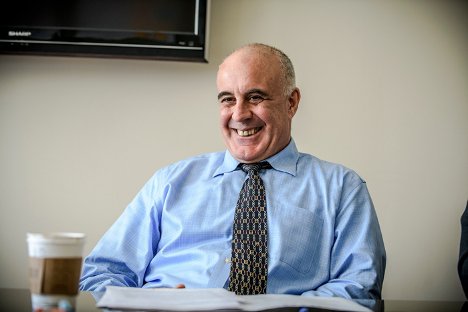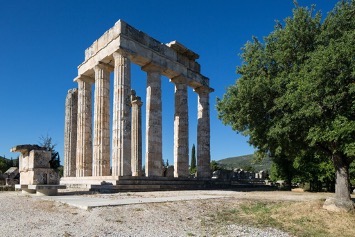SMU Lyle Professor Honored with Prestigious Civil Engineering Award for Groundbreaking Research on Resilient Infrastructure
Professor Nicos Makris’ research on ancient structures has helped modern-day buildings stand strong, even in the dynamics of harsh environments or during natural disasters.

From the ruins of Greece to the megalithic statues of Easter Island, Professor Nicos Makris has found that some of the most resilient structures are ancient.
Through studying these structures over the past three decades, he’s applied valuable findings from the field and research at SMU’s Lyle School of Engineering to the world of modern construction – making the infrastructure we rely on every day more resistant to earthquakes, coastal winds, and other natural forces. He was awarded the George W. Housner Structural Control and Monitoring Medal from the American Society of Civil Engineers in June to recognize his lifetime achievements in engineering research with emphasis on structural dynamics and earthquake engineering.
“His 30-years-long scholarly efforts that combine experimental methods, mathematical modeling/analysis in structural control, and structural monitoring have contributed appreciably to the seismic resilience of the civil infrastructure,” the American Society of Civil Engineers stated on its website. In short, Makris’ work has helped ensure that the structures we use every day will stand strong and function properly, even in harsh environments or during unexpected natural events. Using shaking tables and other experimental methods, what Makris studies in the field can be brought into the lab for testing and later implemented to make buildings safer and more cost-effective to maintain.
—Thinking grad school? Think SMU Lyle. Apply now through Nov. 15 for Spring 2024.
From ruins to revelations
It was an average Tuesday night in Athens, Greece, when a tectonic disturbance deep beneath the Gulf of Corinth was brewing. Nicos Makris – now the Addy Family Centennial Professor in Civil Engineering at SMU Lyle – was in high school at the time, but he remembers that night in 1981 vividly. A wave of energy surged through every street and building from the gulf to the Parthenon as a 6.7-magnitude seismic event began pounding the Athens infrastructure.
“All the buildings in Athens were evacuated,” he said. “People were concentrating in the plazas with blankets. A lot of modern structures had failures, and tens of people lost their lives.”
By morning, the earthquake had taken the lives of 22 people, injured 400, destroyed thousands of buildings, and caused nearly a billion dollars in damage.
“Remarkably, the epicenter of the earthquake was located about 100 kilometers west of Athens near the Temple of Apollo, but the standing columns of the Temple itself, built in 540 BC, never budged,” he said. “This raised the question: How could so many structures built with modern engineering techniques fail, but a 2,500-year-old series of columns could withstand the same powerful earthquake without toppling over?”
Makris has devoted his research to answering questions like this. His surprising findings from decades of research around the world, and now at SMU Lyle, have rippled across academia.
Civil engineering: an ever-evolving discipline
Engineering and building materials for large-scale structures shifted dramatically in the 19th and 20th centuries, Makris said.
“Engineers became fascinated with strength and rigidity,” he said. “Together with the development of applied math and the theory of elasticity, engineers moved away from the concept of articulated structures. These changes have had lasting consequences for modern construction.”
Steel, reinforced concrete, and prestressed concrete became defining features of modern engineering, and although these materials greatly strengthen large-scale structures and allow for heavier loads, they end up experiencing failures under seismic stress. The downside of stiff, monolithic structures during earthquakes is perhaps best illustrated by the collapse of a long stretch of Interstate 880 in Oakland, California in 1989. The collapse killed 42 people.
“It’s something that doesn’t happen often,” Makris said, “but when it happens, the casualties and the damage might be very big. It’s a challenge that has to be taken seriously.” Luckily, he has been successfully challenging the status quo for decades and has achieved better results that have likely saved lives and will continue to stand up under stress for generations to come.
His latest research on urban resilience at SMU Lyle involved a study that collected anonymous cell phone data to determine how quickly a major city like Dallas could return to normal after a natural disaster. This data will help improve the way cities respond to natural events and improve infrastructure.
“There is a strong societal component, but at the same time, there is very fine engineering that comes in association with intense computational effort,” he said. “For students interested in numerical studies, there is plenty to offer here. But I think what distinguishes the things we do in civil engineering from other engineering disciplines is that we deal with problems which are open ended.”
Indeed, Professor Makris’ three professional areas of focus – earthquake engineering, the dynamics of historical structures, and urban resilience – seem to be ever evolving and improving as specialists like himself continue to discover new experimental data and techniques along the way.
“There’s a perception that civil engineering is a mature discipline, that it’s not as hot as other disciplines like computer science or the emerging fields of new data,” he said. “But I think there are still some fascinating problems in civil engineering. I think that it’s a discipline that will continue to serve our society.”
About the Bobby B. Lyle School of Engineering
SMU’s Lyle School of Engineering thrives on innovation that transcends traditional boundaries. We strongly believe in the power of externally funded, industry-supported research to drive progress and provide exceptional students with valuable industry insights. Our mission is to lead the way in digital transformation within engineering education, all while ensuring that every student graduates as a confident leader. Founded in 1925, SMU Lyle is one of the oldest engineering schools in the Southwest, offering undergraduate and graduate programs, including master’s and doctoral degrees.
About SMU
SMU is the nationally ranked global research university in the dynamic city of Dallas. SMU’s alumni, faculty and nearly 12,000 students in eight degree-granting schools demonstrate an entrepreneurial spirit as they lead change in their professions, community and the world.
